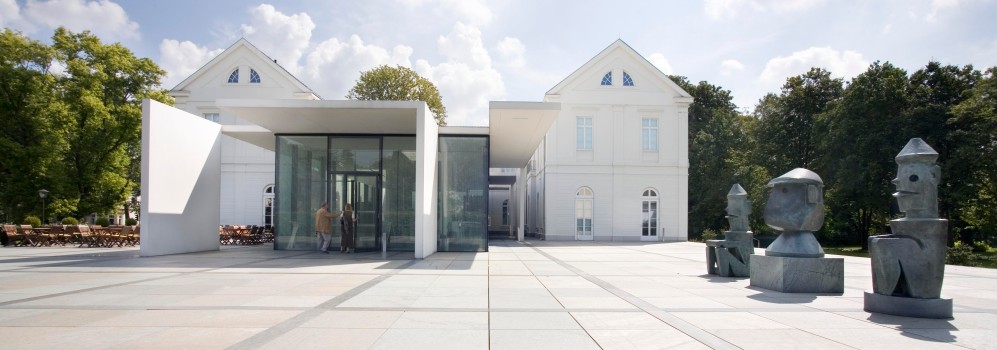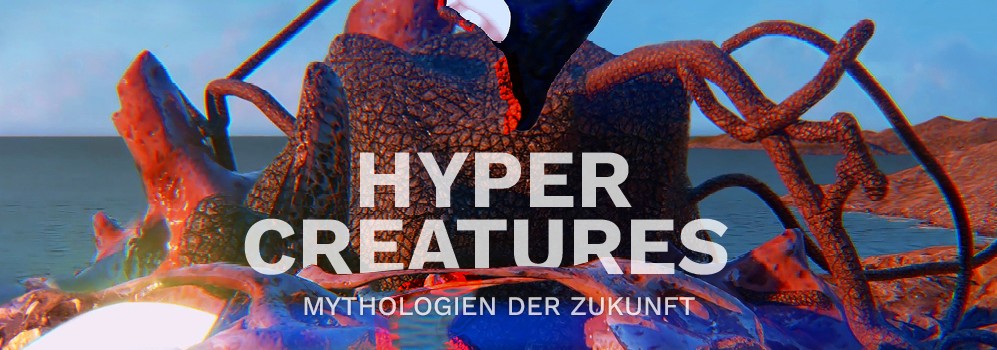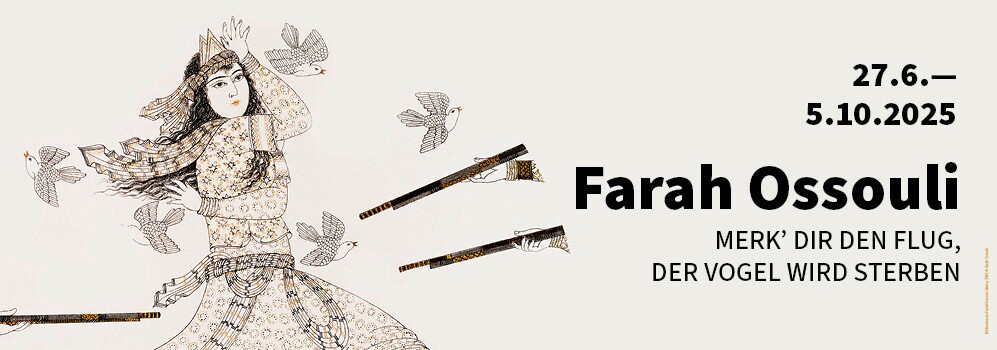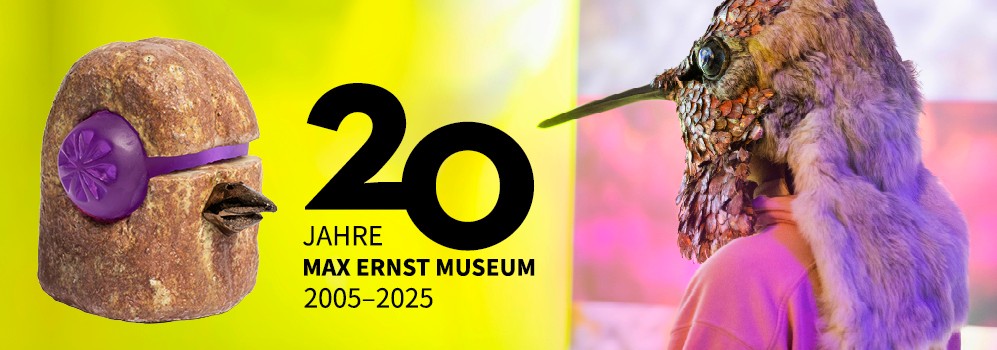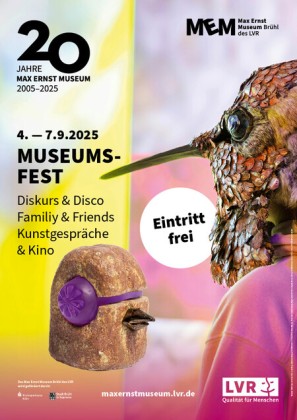
Key Visual des Geburtstagswochenendes mit: Marion Verboom, L‘évadé, 2025, Courtesy Galerie Lelong © VG Bild-Kunst, Bonn 2025, Foto: Nicolas Brasseur; Linda Yasmin Mayer, Annakolibri (Calypte Anna), 2023 © VG Bild-Kunst, Bonn 2025, Foto: LVR-ZMB/Nicole Schäfer
Happy Birthday – 20 Years of the Max Ernst Museum
Museum Festival
Thursday, September 4 to Sunday, September 7, 2025
September 2025: The Max Ernst Museum turns 20!
To celebrate this milestone birthday, we're hosting a vibrant museum festival filled with art, memories, and ideas for the future. A diverse program invites visitors to explore every aspect of the museum and actively participate.
Once upon a time, the artist Max Ernst danced in the "Brühl Pavilion." Today, this former excursion venue along the first railway line between Cologne and Bonn houses the Max Ernst Museum Brühl of the LVR. It opened on September 4, 2005, and has since focused on the life and work of the internationally renowned artist Max Ernst (1891–1976), who was born in Brühl. His eventful life, shaped by both World Wars, took him from Brühl to Cologne, then Paris, into exile in New York and Arizona (USA), and finally back to Europe.

Key Visual der Ausstellung mit: Christoph Westermeier, Sedona Vogel I, 2025 © VG Bild-Kunst, Bonn, 2025; Marion Verboom, L‘évadé, 2025, Courtesy Galerie Lelong © VG Bild-Kunst, Bonn 2025, Foto: Nicolas Brasseur
Join the Celebration of the Artistic Interventions with Marion Verboom, Loplop and Christoph Westermeier, Sedona Vogel (September 4, 2025 to July 5, 2026). Enjoy a cinema evening or be there when the museum transforms into a dance floor. Get inspired by the conversation with Iranian artist Farah Ossouli or get creative yourself with friends and family in our sculpture workshop at the Max Ernst Museum’s Fantasy Lab.
On Thursday, September 4, 2025, at 7 PM, two interventions in the permanent exhibition by Marion Verboom and Christoph Westermeier will be inaugurated.
PROGRAM
Thursday, September 4, 2025 | Openings
3 PM – 6 PM: Vernissage with sparkling wine reception in the Fantasy Lab
For over 20 years, the Saturday Printmakers have been meeting regularly for workshops. In a two-day presentation, they showcase their long-term work. Works by Apollonia Harwarth, Lu Hüls, Berthold Merz, Renate Susen, and Nicole Traut will be exhibited. The five artists work with various techniques including etching, mixed media, and printing with materials and natural objects. For example, an etching gains a whole new dimension through “oversewing,” or a combination of etching and watercolor transforms into a collage through cut-out elements.
September 4–5, 2025
7 PM: Grand Opening in the Dorothea Tanning Hall
Loplop and Sedona Vogel
Marion Verboom and Christoph Westermeier
Contemporary art meets Max Ernst in the collection presentation of the Max Ernst Museum
September 5, 2025 – July 5, 2026
On Thursday, the Max Ernst Museum celebrates its milestone birthday with the opening of two interventions in the collection presentation and invites the public to join.
The Paris-based artist Marion Verboom presents sculptures created especially for the Max Ernst Museum, breaking with traditional notions of sculpture and materiality. Her surrealist objects recall Max Ernst’s assemblages. Düsseldorf-based artist Christoph Westermeier presents his artistic research on Max Ernst, surrealism, and colonialism in a photo collage. Accompanying this, he will give a lecture performance on Saturday, September 6, 2025.
All guests are invited to enjoy music, drinks, and food on the terrace, as well as a DJ set and ambient music with Alisa Berger.
Friday, September 5, 2025 | Artist Talks and Cinema
5 PM: Artist talk with Farah Ossouli, Necmi Sönmez, and Madeleine Frey
Tehran-based artist Farah Ossouli, whose solo exhibition Remember the Flight, the Bird Will Die is on view in the Leonora Carrington Hall, will join again for an artist talk. Together with exhibition curator Madeleine Frey and Necmi Sönmez, editor of her monograph Farah Ossouli – Burning Wings: Last Four Decades, they will discuss Ossouli’s artistic work and present the catalog covering more than 40 years of her career.
7 PM: Film screening: Leonora in the Morning Light and talk with directors Lena Vurma and Thor Klein, moderated by Patrick Blümel
Feature film, 2025, original language with subtitles, 101 minutes
Based on the novel Leonora by Elena Poniatowska, the biographical film Leonora in the Morning Light tells the life of the important surrealist artist Leonora Carrington, who met Max Ernst in 1937. In her art, she combines indigenous Mexican mythology and Celtic folklore to create fantastic worlds.
The exhibition is open until 7 PM on this day.
Saturday, September 6, 2025 | Discourse and Disco
11 AM – 5 PM: Two-day sculpture workshop in the Fantasy Lab: Plastic-Fantastic.
How is a three-dimensional image created in concrete casting? We experiment with different materials.
135 €, 105 € reduced (including materials)
2 PM – 3 PM: Open Saturday tour Hypercreatures – Mythologies of the Future
Dive into the fantastic world of hybrid creatures in the exhibition Hypercreatures – Mythologies of the Future.
5 PM: Lecture Performance The Appropriator with Christoph Westermeier
Artist Christoph Westermeier explores Max Ernst from a postcolonial perspective in a lecture performance. Based on Max Ernst’s life and work, he raises questions of cultural appropriation and foreign authorship, placing these complex issues at the heart of artistic reflection.
7 PM – Midnight: Party Night at the Max Ernst Museum
7 PM: Pub Quiz at the museum café Le Petit Max
Tanja Keck challenges the audience not only with general knowledge but also with questions about art history and Max Ernst. Puzzle together and see who will be the next Max Ernst expert. Typical Rhineland dishes, possibly enjoyed by Max Ernst about 100 years ago, will be served by Le Petit Max
8 PM: Quest in the exhibition HYPERCREATURES
Multimedia artist SOFF takes you on an interdimensional quest through HYPERCREATURES – Mythologies of the Future. Discover the exhibition in a unique way and explore the hidden dimensions of your own being.
From 9 PM: Techno party with DJ duo A2iCE & BO3
Dortmund-based artists Lex Rütten and Jana Kerima Stolzer perform as the DJ duo A2iCE & BO3, delivering bass-heavy, percussive, and genre-crossing sounds. Influenced by breakbeat, techno, bass, and drums from around the world, they create an energetic soundscape. In the immersive mirrored floor installation in the basement, the night becomes a special experience.
Sunday, September 7, 2025 | Family and Friends
On Sunday, families and children are especially invited to the Max Ernst Museum. Expect an exciting program of music, tours, our popular open children’s workshop, performances, and a sound artist who approaches Max Ernst’s works in a completely different way.
From 11:30 AM: Musical brunch with the big band of the Brühl Art and Music School
Under the motto “It don’t mean a thing if it ain’t got that swing,” the big band of the Brühl Art and Music School kicks off the colorful family day with an upbeat concert.
12 PM – 1 PM: Performance with bird masks by Linda Jasmin Mayer
Inspired by Max Ernst’s bird alter ego Loplop, fantastic hybrid creatures wander through the museum. Artist Linda Jasmin Mayer presents a performance with new bird masks inviting reflection on our role as humans and our relationships with non-human beings. Afterwards, visitors can try on and perform with the artist’s bird masks in the special exhibition.
3 PM – 5 PM: Open children’s workshop in the museum foyer
Frottage fun
Using the rubbing technique developed further by Max Ernst, many imaginative pictures are created in the open children’s workshop. Let’s rub!
1 PM and 2:30 PM: Sound workshop
Sound maker and Foley artist Simone Nowicki shows in two workshops how she creates sounds for film and radio plays and lets participating children and families try it themselves.
3 PM – 4:30 PM: Sing-along concert
The children’s choir and youth big band of the Brühl Art and Music School invite all families to join the sing-along concert at the birthday celebration. Perhaps there will also be a birthday serenade for the museum.
Free tours:
1 PM – 1:30 PM
Short tour in the collection presentation: Life and work of Max Ernst
1:30 PM – 2 PM
Short tour of the collection on the life and work of Max Ernst (in English)
2 PM – 3 PM
Tour in the collection presentation: Life and work of Max Ernst in German sign language
2:30 PM – 3 PM
Family tour about Max Ernst
3 PM – 3:30 PM and 4 PM – 4:30 PM
Short tours of HYPERCREATURES – Mythologies of the Future
4:30 PM – 5 PM
Short tour in the collection presentation: Life and work of Max Ernst
Together is best: We look forward to celebrating our birthday weekend with you. Experience all facets of the Max Ernst Museum and meet many artists in person.


